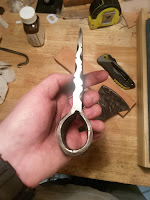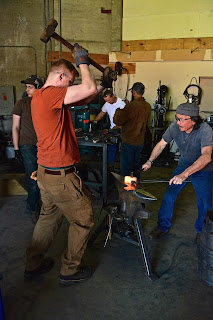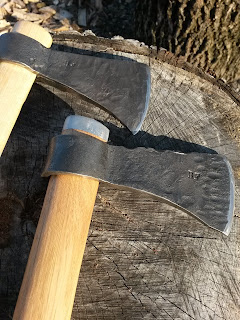I've mentioned this in my previous post. I know I've talked about this a lot with the people around me. I know, I know. The truth of the matter is, though, I'm very excited. Much of my excitement comes from the prospect of using what I make but with this ax I'm far more excited than I have been. You may be wondering why? Simple. This is the biggest thing I've made so far, it's made for heavier work than anything else I've made... and I'll be damned if I'm not going to put it through the works.
 |
| After rough forging and grinding back at our shop. |
After forging this beast, I look at folks like Liam Hoffman, John Neeman, Justin Burke, and any of those other folks you see that forge and sell drifted eye axes and think "hat's off to you, folks. You guys do a lot of hard work". It's a whole new level of appreciation for their work. Power hammer, sledge hammer, press, or forging hammer... it ain't easy, folks.
 Then, with all of that rabble said previously, we must also look at the handle. I've carved a few handles so far... they weren't really too bad. Go to town with a draw knife, rasp, and sand paper. A hour or so later, you've got yourself a decent handle. Carving the handle for this axe was a bit different. I purchased a nice kiln dried ash board from Nick Thrane of Thrane's Axe and Saw Co, which was hand picked by him for carving axe handles. I wanted something a bit easier to carve than hickory, but something that still got the job done. First, I drew out my template on the board with the grain orientation I desired. Then I took the design to the band saw and cut out my rough shape. At this point, I had a hard time deciding what to do next. I thought "Well, I'm an Axe Junkie... so I could go to town on this with a carving axe or I could start with the draw knife...". Long story short, I'm glad I decided to use the draw knife. The wood is dried and I feel like I would have had a lot of splitting going on if I had used an ax.
Then, with all of that rabble said previously, we must also look at the handle. I've carved a few handles so far... they weren't really too bad. Go to town with a draw knife, rasp, and sand paper. A hour or so later, you've got yourself a decent handle. Carving the handle for this axe was a bit different. I purchased a nice kiln dried ash board from Nick Thrane of Thrane's Axe and Saw Co, which was hand picked by him for carving axe handles. I wanted something a bit easier to carve than hickory, but something that still got the job done. First, I drew out my template on the board with the grain orientation I desired. Then I took the design to the band saw and cut out my rough shape. At this point, I had a hard time deciding what to do next. I thought "Well, I'm an Axe Junkie... so I could go to town on this with a carving axe or I could start with the draw knife...". Long story short, I'm glad I decided to use the draw knife. The wood is dried and I feel like I would have had a lot of splitting going on if I had used an ax.The absolute most difficult part of this whole handle was shaping the eye of the axe, which is what I did first. Being my first handle for this kind of axe, I had a bit of trouble. My axe was forged at my mistake with a pretty small darn eye. After 3 or 4 hours total of rasping, scraping, sanding, and carving, I finally got it to fit!
After a few hours with the draw knife, I switched it around to the spokeshave. I ordered a spokeshave for this project, as I've never used one nor did we have one on hand. What an interesting tool. I ordered the Stanley 12-951 Spokeshave with a Flat Base. Pretty nice out of the package, though I quickly became frustrated with this tool because of how quickly it got clogged. I couldn't figure out what the gig was, only to realize it had a lip on the razor blade. I did have to take the blade off and put it on a strop a few times to remove the lip on the razor blade edge. After doing so, it glided down the handle and threw curly strips of ash like confetti. I need to get one with a curved base. That's on my shopping list next.
After sanding it down a bit, drilling a handle hole, cleaning up the end of the handle, I hit it with 6 coats of boiled linseed oil. The handle is nice and smooth, a bit thicker for my bigger hands, and feels great under the weight of the head.
The only remaining thing is the heat treat. According to Liam via messages and at our class in which this axe was forged (see previous post) this head needs a agitated quench and a nice soak at 400 degrees for a few hours. Hopefully using veggie oil doesn't bite me in the butt. We'll see though! I'll post some updates with the field test.
 |
| Mock up fit of the axe head on the handle. Pre-heat treat. |



